There are two kinds of people in the world: regular, and birders. Usually, identification is easy. Birders are the ones wearing binoculars. But there’s also an intermediate phase–the pictures in the guide book are of Dave and me–the swell-hearted clueless aspiring birder. This form also wears binoculars, so you have to look for the random ass-scratching and perplexity around the eyebrows.
Dave and I would like to complete the transition into full birder, but we have problems. It doesn’t just happen on its own. I once got a very clear look at an enormous bird with distinct markings, every one of which I memorized, and when I checked it in a field guide, it exactly matched a bird whose entire range is the southern slope of a single mountain in a country I can’t get a visa to, and you’d think birders would get excited about a thing like that, but they don’t.
So when Dave read about Bonney Butte, a prominence on Mt. Hood at which the fall migration of raptors is particularly splendid, we went to see. Here the selection of birds was likely to be contained in three pages of the guide books, and we thought we’d have a good chance of being able to identify them. Just to get in the mood, we attempted to reach the place using directions off the internet. They were very specific, advising us to “make a sharp left at 6.8 miles on a rutted road you’re too liberal to have a vehicle with high enough clearance for.” They called it “unsigned Road 4890,” and it looked pretty much like every other unsigned road–no identifying marks, indistinct plumage, and no particular correlation to the mileage indicated. I’ve been following hiking guides for a long time now, and I am not fooled by this sort of precision. 6.8 miles can mean 7.2 miles or 4.6 miles, or, in some cases, it can mean–ha ha!–that there is no road at all. Sometimes this is a result of deliberate sabotage, and sometimes it means the writer of the hiking guide had a very nice hike and tried to estimate, back home after the fifth beer, about how far down the road that particular turn-off was.
Anyway, we finally gave up and parked on the shoulder somewhere near sea level with Bonney Butte jutting in the distance, and started walking up. By the time we arrived, we joined a dozen people who had no difficulty with the directions and were parked nearby. We were the ones with 1800 vertical feet of righteousness, and they were the ones with unfogged binoculars.
Half of these were pros, employed by HawkWatch International, and they were counting raptors on their migration. There was also a banding operation going on. A “raptor” is defined as a “bird of prey.” If you don’t mind my saying so, this is a little dismissive of your robins or woodpeckers, which do one heck of a job locating prey that isn’t even visible, let alone flapping or squeaking. The people who make these distinctions are way more impressed by birds that eat other birds or mice or something. So be it. You may be the world’s champion finder of invisible insect larvae, but you don’t get to be called a raptor, no sir.
So we settled in, anticipating a casual afternoon sitting on a warm rock watching soaring birds drift upwards in such a way that we could finally–finally–learn their names. Specifically I anticipated that I would see a tableau that matched the introductory raptor page of the field guides, in which birds hung stationary in the sky, wings out, with all conceivable characteristics displayed, in such a way that their minute differences were evident.
Not so much. Our birds were dots on the horizon, up to fifteen miles away. Nevertheless the pros were confidently marking them down as one bird or another. “Red-tailed,” one would say, squinting into his binos. “Male. Immature,” he’d conclude, as the dots popped wheelies in the sky. I don’t know how they did it. As one confided, “you can definitely tell a female Sharp-Shinned hawk from a male Cooper’s, but there’s a whole intermediate range where you’re just going to have to give it your best shot.” Let’s check the field guide for the differences, shall we? Sharpie: Adults blue-gray above, pale reddish below; young brown above, striped below. And the Cooper’s: Adults blue-gray above, pale reddish below; young brown above, striped below. Hmm. Sharpie: tip of tail usually looks squared-off, but can look rounded. Cooper’s: tip of tail more rounded (can be hard to judge). All-righty-then!
What it comes down to is that there are significant variations depending on whether the individual is young, lost, evolutionarily creative, or just messing with you. Fortunately for us, we were able to observe one bird close up, when the banding operation scored a Sharp-Shinned hawk that had blundered into its net. [Note: you are not interested in knowing how hawks are lured into the net, any more than you would like to be a pigeon.] Our temporarily captive Sharpie struck us, primarily, as small. And it was a large one, being a female. Most female hawks are larger than their mates, and not just through the hips.
How they resolved the dots is still a mystery. For each species there’s a regular phase, and a winter phase, and an immature phase marked by general dishevelment, plus random variations for vagrants, and assorted gang colors. The writers of the bird field guides are not as careless as the hiking-guide people, but their product still falls short. They are sorry about it, they really are. They know how to tell the birds apart, but they have to keep it simple so as to avert despair and burn-out in the novice birder, and refrain from details such as the particular wardrobe favored by female goshawks on Bunko night, or the freckled camouflage of juveniles sneaking out on a toot.
So I didn’t really learn much. But I was happy to serve as a dot-spotter, hollering my find on the horizon and causing three real birders to wheel my way and squint my dot into a slot on the hawk count. Proud, even.





I love watching the birds but gave up on identification early on. Now I just happily say, "oh look, a bird".
You didn't try bluffing about the dots? Who would have known different. They were likely all bluffing.
I went bird watching once. Spotted a yellow-headed double-breasted bed-thresher.
I come from a long line of people who LOVE birds. What a great hobby…
Pearl
I went on a raptor field day once, there I was with my binocs along with all the professionals, and I saw things I never suspected were out there. The leader guy caught and banded a big red tailed hawk, it was cool to watch but I did feel sorry for the manhandled bird.
As usual, you have brought lots of smiles into my bedroom early in the morning. Almost as good as a tickle fest with my hubby. 🙂
Fun read. I can picture you two watching through your binocs. We have binocs here and run for them when we think we see something.
The hawk in those photos seems remarkably well-behaved, for having been momentarily kidnapped.
Quick question: are vultures considered raptors? They eat flesh, but are predominantly scavengers rather than predators.
I feel your pain. I've spotted birds that don't appear in any book, so I'm convinced I have a knack for discovering entirely new species. As you mentioned, the "real" birders seem unimpressed.
But I have a secret weapon: the LBB. You can whip this one out if you need to impress your companions. When you catch a glimpse of movement in the undergrowth that could be a bird, a squirrel, or a leprechaun, just nod confidently and say, "Yep, it's an LBB*."
*LBB stands for "little brown bird", but they don't know you're spelling an acronym. It sounds enough like "chickadee" that they're afraid to call you on it. Trust me.
Gorgeous photos. I have never seen that particular type of hawk. Beautiful markings. We have a red-tailed hawk that lives around here. I love their cry. Last year we had a prairie hawk hanging around our bird feeders for a few days snacking on finches and sparrows. It kindly left a pile of feathers and beaks on our back patio, not exactly what we had in mind when we hung the feeders.
Of course we have lots of magpies, blackbirds, crows, etc. My husband refers to them as "the assholes of the bird kingdom." I think it fits.
Aren't raptors actually "birds that seize their prey (with their feet)"? It's not the preying, it's the grabbing that's being specified. (rapiō, Latin, "to snatch, to grab, to carry off.")
(Not that I would not change a word of this post: yet another jewel.)
I'm with mybabyjohn/Delores but sort of envy the "real" birders.
Diane, I can't impress my companions with "LBB." Half of my companions are birders. In fact, I'm the only birder out there with a life list of birders longer than my life list of birds.
I admit, I did wonder if the pros were bluffing. They seemed so serious, though.
Ahab, I think vultures are usually considered raptors, just with a different sort of work ethic. And Dale, you're right, as usual. Now I'm going to be on the lookout for that one innovative woodpecker that drills out a hole in a tree and then pulls bugs out with his feet. And I'm going to name him after me.
All subsequent questions will probably be answered by my birding buddies when they descend on this hapless blog post and begin ripping it apart with their beaks.
Oh, Murr!!!!! I love all of your posts, but this one is hands-down my favorite!
While I'm wiping my eyes, I'll tell you this: Don't give up on raptors! When I was a beginner, I didn't know a Coop from a RTHA. I had never even heard of a red-shouldered hawk. And now I teach about them.
Holy crap, you make me laugh.
Husband took an ornithology class in college. He loves the field guide, and appears able to memorize the descriptions. I am like you. They look like dots-some more rounded than others. He will say "Oh, it had a v-shaped tail, and the head was white, it must be a …. " and all I'd be able to tell him was that the bird I saw was sitting on a branch-over there. I do love to see the birds, though-except that the woodpeckers are currently attempting to move in with us.
Well, I love 'em.
I'm not a full-fledged (used advisedly) birder, but I am a watcher and I enjoyed the trip with you. Raptors are a special passion of mine. We just passed through the area you mention in early June of this year.
Oh cripes, I was raised by birders. Avid ones with big life lists. Binoculars on the dining room table types. Dinner plates and cutlery flying as one leapt to their feet screaming "there's a feeble minded whatnot on the feeder", leaving my brother and I clutching our hearts. I said I never would but find myself doing it now too.
Wow, birding for raptors! My kinda trip. I went on an Earthwatch trip for 2 weeks back in the 80's at the top of the Goshute Mountains in Nevada just at the edge of the Great Salt Lake Desert. Learned all about how they get the Sharpies and others to fly in their nets. My favorite was sitting in the blind one day and being swooped by a Golden Eagle who tore through the mist net. Just gunned it and was gone! We could hear his wings before we saw him.
The Sharpie looks docile because he's been caught. They go into kind of a trance and are amazingly cooperative. Course the moment you release them into the sky they let loose, quite literally, because you've no doubt just scared the shit out of them!
I used to try to ID everything. Finally I realized it was keeping me from enjoying myself, so I stopped keeping a list and never looked back. Same with tripods and big lenses. I once saw a guy spend five minutes concentrating on a Tricolored Heron that was about 20 yds. away, and he never saw the one standing on the railing about 15 feet behind him. That'll never be me again. Now I carry a 75-300 zoom, and what I get is what I get.
Bring Dave to New River next year, and we can all look bemused(wildered) together…let Julie and Bill do the work.
Here is how I identify birds–"Look up there! It's a bird!" Oh, sometimes if the bird has a color I may say it is a red bird or yellow bird or blue bird. I do know Stellar jays, scrub jays and crows!!
I like seeing them but not too hep on being a pro as to exactly what I see. "Look! A pretty bird!"
Quite the birder you have become. Well done!
My mom used to band birds, and had nets and stuff like that. I used to help. No time for tales today. But, yes, I was a birder from a young age.
When you're working with raptors, leather gloves are advised. Well, at last one.
Raptors are fascinating. But one above all others — the veloci-raptor. You don't want to catch that one. Trust me.
What's so cool about most birders is their willingness to share info. We were hiking Smith Rock (taking the heart attack way up instead of the die by cliff face) and found birders at the top with telescopes trained on a bald eagle's nest. Since then, I've been thrilled to encounter birders who help me become a little smarter. Nice post.
We love our birds and are getting better about identifying visitors. It would be difficult to get worse. And you are so right about the out and out vagueness of bird bibles. sigh.
If only Post-its stuck to them.
Yes, vultures are raptors(it's the strong feet that clinch the ID), as is the funny-looking Secretary Bird(Africa), again, has those powerful feet.
When The Man and I were involved in Raptor Rehab [not the drug-dependent kind!]I lost count of the people who called us with "an owl" which 99/100 was a frogmouth, a kind of nightjar.
It was interesting, but sometimes harrowing, especially birds suffering secondary poisoning.
I love seeing the raptors and am fairly good at identifying the ones common in my neck of the woods, but it's the little guys whom I enjoy the most. I never tire of watching a Carolina Wren or a Titmouse work the bushes around the house.
What a lovely trip up the mountain I took with you this morning.
I was the one who pointed out the crows on the way up, because crows are 1) really intelligent, 2) mate for life, 3) take great care of their young, 4) take up residence where the food is, and clean up after picnics.
The red-shouldered hawk has built a nest within sight of my bird-feeder. Not to happy with that family.
This is the most fun I've had all morning since my computer is on "safe mode" because the #@$*% thing won't start properly and my son has been patiently/resignedly coaching me over the phone to backup my files…sort of like identifying birds. Thanks for the merriment!
Huh, Mr. Charleston, I've never seen a titmouse work the bushes. I have seen a hundred titmice work the bushes…
Shaatzie, around here crows also serve as mandatory installations on art. We must "put a bird on it," and nine times out of ten it's a crow. I'm a fan, myself.
Anon, that is my definition of hell. Anyone remember when we didn't even have computers and still managed to draw breath?
When preying for bird views it is the intent, not the ability or sucess of identifying a species that makes one a 'birder'. In other words, you tried and it's not your fault there is no 12 volume set of the Encyclopedia of Bird Plummage for you to even afford, let alone carry around with you!
Thanks for putting into words what so many of us who try have also noticed, and still having fun!
Oh, and Dinahmow, you are in blessed territory. I saw my first nightjar last year. It did look a little like an owl in a recliner.
Nothing has convinced me that Cooper's and Sharpshinned are really different birds. Martha had a fun little birdcall thingy that made them sound very different, but I bet they were just saying different things (one was fluting "dinnertime!" and the other was screaming "back off, buddy!")
You gave it your best shot and we're all proud of you.
I've discovered that birds know real birders from amateurs. I saw the most bird species ever while working for a world class birder. He threw a feeder and a drip water feature out into the lot adjoining our office and–ta da!–I was spotting rose-breasted grosbeaks and logger-head shrikes out Mr. Birder's windows that would never have showed up at my house two miles away. It's another of those bird mysteries, like how they know to avoid commercial airline flight corridors.
OMG! This post sounds like it's about me!!! I laughed all the way through. I can't tell you how often I have seen a bird thinking I would remember every detail. Looking in a bird book I would invariably find what I thought was the bird only to notice that it isn't found closer than 2,000 miles away from here, in any season.
Himself is a birder at our house, and I'm along for the ride. He's the guy who studied wildlife management at Humboldt State the year the bottom fell out of all the funding for state parks, etc in CA. He knows bird calls, he id's everything at a gazillion yards, he's banded spotted owls (remember them?) and does the Xmas bird count and the eagle count here every year.
He's hell to drive with though…barreling down the road at 60 and stopping on a dime to say "Look!!–Prairie Falcon!!!" Or forgetting that he's the one driving because there's a Black Crested Night heron over there….
For some reason, : ) this made me think of you and my friend who introduced me to your blog. Enjoy!!!
http://vimeo.com/31158841
Nance, another of the bird mysteries is how they avoid EACH OTHER, as in the vimeo CTrew put in, above. CTrew, you're only the twelfth or so person to send that to me this week, which just shows it's true what they say about great minds! In case any of you missed it, I wrote about the phenomenon in 2009, right here.
Well one needs more than a set of binos; one needs vision and smarts to go with that. I seem to be lacking in at least one if not both. Still I love those I am able to see and hear.
I am good at identifying birds, until it comes to raptors. Unless it's a Bald Eagle or an American Kestrel, I have problems, although I'm getting quite good at i.d.-ing Northern Harriers. Sharpies vs Coopers? I can't do that even when I take a photo of one eating a bird at my feeder….